SID Symposium Aglow with OLED Displays
SID 2006 set records in terms of numbers of papers and exhibitors, and the technology that received the most attention both during the Symposium and on the exhibit floor was OLED displays. Here's a look at the most interesting developments at SID 2006 for this emerging technology.
by Paul Drzaic
ORGANIC-LIGHT-EMITTING-DIODE (OLED) DISPLAYS are viewed by many as the future of flat-panel displays, and with good reason. In addition to their relatively simple construction, OLED displays meet or exceed the performance of active-matrix liquid-crystal displays (AMLCDs) in nearly all display parameters, with particular strengths in response time and viewing angle. Nevertheless, AMLCDs continue to lead OLED displays in size, lifetime, and manufacturing cost, and presently dominate the flat-panel-display industry. AMLCDs will not give up their industry supremacy easily.
It is no wonder, then, why OLEDs have caught the imagination of the flat-panel-display community. This intense interest was illustrated during the SID 2006 International Symposium, Seminar, and Exhibition that took place in San Francisco in June. OLEDs permeated nearly all of the different offerings at SID 2006; more sessions at the SID Symposium were dedicated to OLEDs than any other technical topic, and OLEDs were also the subject of numerous papers presented in sessions focusing on backlights, display electronics, display manufacturing, and display measurement. Eleven invited talks and nearly 60 posters were focused on OLEDs.
This article will highlight some of the notable OLED-display activities at SID 2006; in particular, displays demonstrated at the SID 2006 Exhibition. This short article does not comprehensively cover all the noteworthy events, but information about SID 2006 is available through www.sid.org.
The Display Technology Seminars and Applications Tutorials, along with the Business Conference, provided a solid review of the current state of OLED technology, manufacturing, and business, plus roadmaps for future technology and business development. In his seminar on OLED Manufacturing Technology, Gopalan Rajeswaran of Kodak offered a view of the competition between OLED displays and AMLCDs. Rajeswaran noted that many of the performance advantages of OLED displays over AMLCDs have been reduced due to improvements in AMLCD response time and viewing angle. Therefore, the cost of OLEDs will be critical for industry growth – to compete with AMLCDs, OLED displays will need to reduce costs primarily through improvements in OLED-display backplane yield and throughput in OLED-display fabs.
Kimberly Allen of iSuppli Corp. mirrored several of these points in her Applications Tutorial, "Emerging Displays Among Giants," pointing out the processing (tact) time for a passive-matrix OLED (PMOLED) display is currently about 4 minutes, while a color supertwisted-nematic (STN) LCD has a tact time of 30 sec. About $500 million worth of PMOLED displays were sold in 2005, according to Allen, and in 2006, the outlook is for $740 million in PMOLED-display sales, primarily for use as mobile-phone displays and in portable media players. Allen forecasts that unit shipments of active-matrix OLED (AMOLED) displays will not surpass PMOLED displays until 2010. She also noted the interesting dynamic within the display industry that has OLED displays competing with AMLCDs even though most of the companies developing OLED displays also sell AMLCDs as their primary display business.
While the seminars provided a view of industry trends, the SID Exhibition provided a real-life set of benchmarks for the progress achieved and products made using OLEDs. For example, OSRAM Semiconductor showed a number of products and prototypes incorporating its line of PMOLED displays, including a shelf-label video display (Fig. 1), displays for audio systems, Bluetooth headsets, and medical devices. In other passive offerings, Univision Technology, Inc., displayed a number of 1.7-in. PMOLED displays with beautiful contrast and color rendition (Fig. 2).
Paul Drzaic serves the display industry as a consultant through Drzaic Consulting Services; e-mail: drzaic.consulting@verizon. net. He is a Fellow of the SID and the President-Elect of SID
 OSRAM Semiconductor
OSRAM Semiconductor
Fig. 1: A shelf-label video display incorporating a PMOLED display from OSRAM Semiconductor.
Active-Matrix OLED displays
While PMOLED displays are being manufactured and sold in volume, it appears to be a near-consensus in the industry that AMOLED displays will provide the best combination of price and performance in the future. A number of exhibitors at SID 2006 were showing innovative AMOLED displays.
Samsung demonstrated a number of noteworthy display panels. Two panels (10 and 11 in., respectively) were small-molecule AMOLED displays built using amorphous-silicon (a-Si) backplanes (Fig. 3). The 11-in. panel was reported to exhibit a contrast ratio of 1000:1 at a luminance of 300 cd/m2 in a 800 x (RGB) x 480 format. Stability issues have dogged a-Si-based AMOLED displays in the past, but the promise of compatibility with backplanes built by the same fabs that crank out low-cost AMLCD backplanes are driving interest in the field. In a sign that a-Si OLED technology still requires some development, Samsung recently announced the construction of a Gen 4 low-temperature polysilicon (LTPS) OLED-display fab. Samsung also demonstrated a novel 4.3-in. 3-D OLED display that creates the 3-D effect by using the OLED display panel's fast response time to provide time-sequential images with differing parallax.
A number of display companies exhibited LTPS AMOLED displays. TPO – formed from a merger of Toppoly Optoelectronics Corp. and Philips MDS – exhibited 2.5-in. LTPS OLED displays. Kodak showed a digital camera containing a 2.5-in. LTPS OLED panel with materials for improved lifetime and color gamut. Toshiba-Matsushita Display Technology Co., Ltd. (TMD) exhibited both 3.46- and 2.2-in. QVGA LTPS OLED displays for portable devices. Not wanting to distract attention from the 100-in. LCD-TV in its booth,LG.Philips LCD demonstrated several LTPS AMOLED displays in private, including 2.4- and 2.2-in. QVGA versions.
eMagin's AMOLED displays took on a little different form factor, showing several microdisplay viewers built using OLEDs on a single-crystal silicon-chip-based backplane. For example, the eMagin Z00 3DVisor is reported to display images equivalent to those viewed on a 105-in. display from a distance of 12 ft. eMagin expects more than 400,000 hours of lifetime from its latest improvements in materials and construction.
Fraunhofer Institute for Photonic Micro-systems (Fraunhofer IPMS), part of the German Pavilion at SID 2006, demonstrated several OLED devices, including a remarkable transparent OLED display that could be viewed from both the "front" and "back" of the display. During the Symposium, Fraunhofer Institute for Applied Optics and Precision Engineering (Fraunhofer IOF)presented a paper (paper 13.1, Riehemann, et. al.) in conjunction with Nordic NeuroLab AS on a 3-D-capable head-mounted OLED medical display.
Cambridge Display Technology (CDT) and Toppan Printing showed a 5.5-in. full-color active-matrix polymer OLED (P-OLED) display using a relief-based roll-printing method. Compatibility with printing technology is often touted as a fundamental advantage of P-OLEDs [compared to small molecule-based (SM) OLEDs, which usually require evaporation through a shadow mask]. CDT and Toppan raised the bar by showing compatibility with a process that potentially has extremely high throughput (Fig. 4).
|
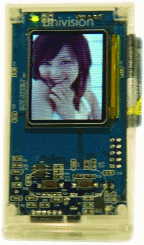 Univision Technologies, Inc. Univision Technologies, Inc.
Fig. 2: A full-color 1.7-in. PMOLED display from Univision.
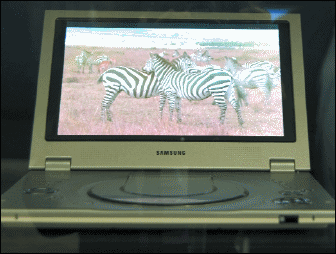 Samsung Samsung
Fig. 3: A 10-in. AMOLED display using an a-Si backplane from Samsung.
Firing back from the small-molecule side, DuPont Displays showed a 6-in. OLED panel fabricated through jet-printing of SM-OLED materials in a recently developed process. While DuPont did not report on the exact nature of the system, it claimed the invention will enable a large number of SM-OLED materials to be transformed into printable materials (Fig. 5).
The University of Cologne, in conjunction with Merck, described a process in a poster paper (paper P.181, Gather, et. al.) in which lithographic patterning is performed directly on the OLED materials without the use of additional resists. By chemically modifying OLED materials to become photo-responsive, a uniformly coated OLED panel was exposed with light, making the OLED in the exposed areas insoluble. Development of the image with solvent washes away the OLED from the unexposed area.
Universal Display Corp. (UDC) reported a number of advances, including newly improved blue emitters based on phosphorescent OLED (PHOLED) materials. High-efficiency blue emitters have been challenging to date, but UDC reported a 50% improvement in efficiency, with a blue material showing 30-cd/A efficiency and a 100,000-hour lifetime at 200 cd/m2. In conjunction with the Palo Alto Research Center (PARC), UDC described a 100-ppi flexible OLED display built on an LTPS stainless-steel backplane (paper 64.2, Chwang, et al.).
The Distinguished Paper "High-Efficiency Tandem Blue OLEDs" from Kodak (paper 23.3, Liao, et al.) described "tandem" blue displays that were constructed by two electroluminescent units connected in series by an organic conductor. This yielded 20-cd/A efficiencies, with lifetimes at 1000-cd/m2 luminance found to range from 5000 to 50,000 hours, depending on the material.
White OLED materials were another area that received a lot of attention at SID 2006, with several notable achievements. A joint research effort between Novaled GmbH, Philips Lighting, and Philips Research produced a white OLED with an efficiency of 32 lm/W and a lifetime of 20,000 hours, when driven at 1000 cd/m2 (Fig. 6).
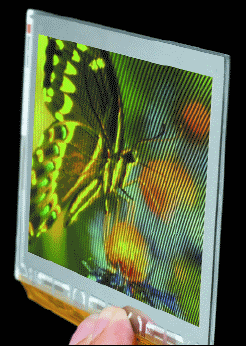 CDT/Toppan Printing CDT/Toppan Printing
Fig. 4: This 5.5-in. OLED display from CDT, which was fabricated using a roll-compatible relief-based roll printing process in partnership with Toppan Printing, made its debut at SID 2006.
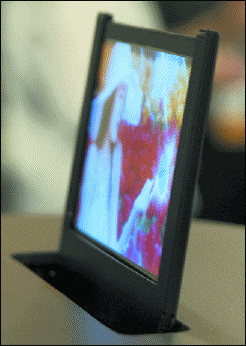 DuPont Displays DuPont Displays
Fig. 5: A jet-printed small-molecule (SM) OLED display from DuPont Displays.
Mitsubishi Chemical Corp. demonstrated how printable electronics can be used to drive OLED displays. Mitsubishi Chemical developed a solution-processable small-molecular material that offers a high mobility of 1.4 cm2/V-sec. Such mobility is equivalent to what is found in a-Si materials. Mitsubishi Chemical also described laser patterning of these materials. •
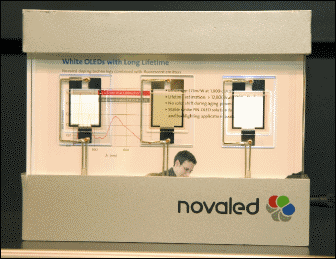 Novaled GmbH Novaled GmbH
Fig. 6: A transparent, white OLED panel from Novaled GmbH.
|